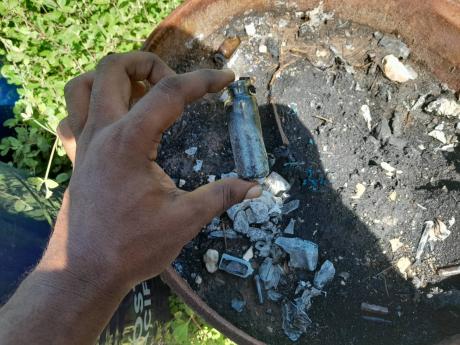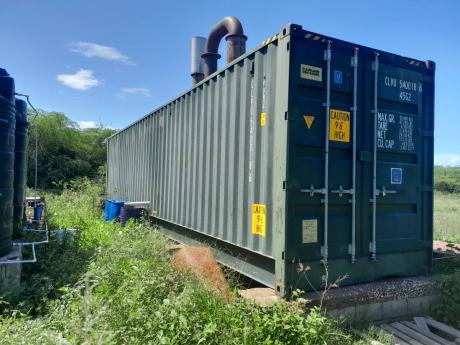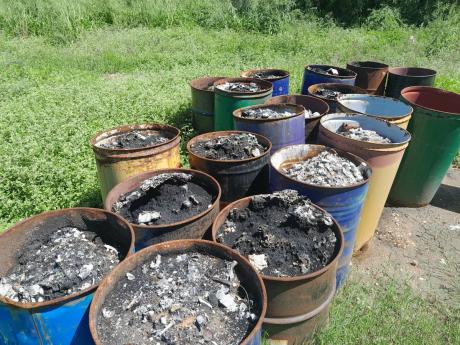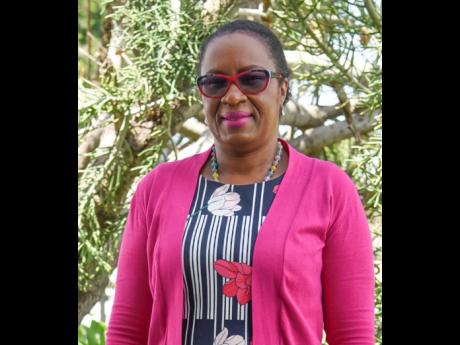MEDICAL WASTE SCARE
• Residents on edge as incinerator pops up on outskirts of community • Concerns heighten about health risk, contamination of water
The drains are blocked and the roads are flooded and muddy whenever it rains. Piped water is non-existent, and so, too, are street lights – their absence brightest after dark. Now, residents of Hartlands, a farming community in St Catherine, are battling another concern – that of a mystery medical waste incinerator they fear might be putting their health at risk.
It popped up overnight about two years ago, explained Ann-Marie Jenkins, interim president of the Hartlands Community Citizens’ Association, and since then, it has illuminated the skies on some nights, releasing hazardous smoke into the atmosphere.
It appears the incinerator, built from a container, is the final destination for tonnes of medical waste, some of which may be toxic; and Jenkins and other residents are demanding answers before anyone in the community with some 300-plus homes begins to fall ill.
“We don’t know what is burning there. We don’t know if it’s seeping into the underground water, and remember that people do farming here and use irrigation water,” a concerned Jenkins told The Sunday Gleaner. “We don’t know whether or not this thing is polluting the air and we can get sick from it.”
She said that the identity of the operator of the incinerator remains a mystery as despite multiple attempts to locate the responsible party, her efforts have come to nought.
“We need answers. Somebody needs to tell us something,” the citizens’ association head insisted. “People down here suffer from asthma; others like myself suffer from serious sinusitis. I don’t know if it is because of the incinerator, but at night-time, I can’t breathe. Sometimes I have to get up and sit up in the bed to catch my breath.”
GUIDED BY INTERNATIONAL PROTOCOLS
The Sunday Gleaner gained access to the unsecured property housing the incinerator quite easily last week.
There was no perimeter fence or signs to indicate the operators or the nature of their activities at the location.
The incinerator was inactive during a visit by our news team, but more than a dozen drums filled with ashes were seen as well as burnt debris scattered around the apparatus. Inside the drums, there were small glass vials, and charred packets of tablets.
Jamaica is guided by the Stockholm Convention on the Elimination of Persistent Organic Pollutants (POPs) and the World Health Organization (WHO) Policy Paper on Healthcare Waste Management regarding the treatment of medical waste. The Stockholm Convention is a global treaty to protect human health and the environment from POPs, which are chemicals that remain intact for a long time.
According to the WHO, some hazards that may arise from the disposal of medical waste are the contamination of drinking water if landfills are not properly constructed or maintained; occupational risks at disposal facilities that are not well designed and run; and the incineration of waste containing chlorine, which results in the release of pollutants in the air that are human carcinogens and detrimental to health. Chemicals used in waste treatment are also potential sources of water pollution via the sewer system.
PUBLIC AT RISK
“The disadvantage of incineration as it relates to health is the emission of highly toxic fumes such as heavy metals, dioxins, particulate matter, carbon dioxide, nitrous oxide, ammonia, and organic content,” offered Sherika Whitelocke-Ballingsingh, public health inspector and head of the Caribbean Poison Information Network.
Particularly appalled by the questionable waste disposal site near Hartlands, Whitelocke-Ballingsingh explained last Thursday that there may also be other emissions that are not known because of the way waste is at times mixed for incineration. Some of these emissions are carcinogenic, endocrine disruptors, and can severely impact the respiratory system.
“Presently, there are two main practices of medical waste disposal in Jamaica: incineration done by some facilities, and at the medical waste treatment plant (a shredder-like system) located in downtown Kingston,” she offered. “Due to the limited capacity of the medical [waste) treatment plant to serve all facilities (public and private) in Jamaica, the practice of incineration is still used, which puts the public at risk.”
The poison expert added that stockpiling of medical waste over the years has resulted in permanent challenges for many countries and facilities.
“Jamaica needs far more capacity and infrastructure to deal with its medical waste as the present system predisposes workers and those in the environment of waste disposal treatment plants or facilities to be at some level of risk,” she added.
As no known air-quality testing has been done in Hartlands, it is unclear to what extent the air has been polluted, particularly by the incinerator, Whitelocke-Ballingsingh underscored. The residents also noted that the area is known for the burning of coal, which also causes respiratory complications.
STUMBLED ON AN ILLEGAL SITE
The Sunday Gleaner understands that the Medical Solid Waste Management Unit located on Drummond Street, in front of the Kingston Public Hospital, has long past its capacity to deal with medical waste from public health facilities across the island. As a result, the Government contracted CEAC Outsourcing Company to help discard medical waste across the island.
CEAC operates a disposal facility in St Catherine and Managing Director Christopher Burgess was particularly relieved last Friday that the incinerator in question was not his. Based on his observation, however, the Hartlands site was clearly in breach of the Ministry of Health and the National Environment and Planning Agency (NEPA) guidelines dictating the operation of medical waste incinerators.
The fact that the facility is unsecured and accessible to the public is of particular concern, he pointed out, adding that contrarily, his disposal site has a perimeter fence, closed-circuit cameras, and 24-hour security. Medical waste, Burgess outlined, must be separated and hazardous toxic items must be properly sorted and labelled before disposal. Some parcels are not allowed to be opened once sealed for pick-up at the health facilities.
“Ninety-nine per cent of it is like diapers and bandages, when the surgeons dress cuts and so on, and our incinerator burns at a very high temperature and reduces almost everything to dust,” he continued, noting that a smoke escape, commonly called a stack, as depicted at the Hartlands site in question, was clearly not tall enough as per the stipulations of the authorities.”
He continued, “You want to be far from people, you want at least 200 metres from people, and you want the stacks to be much higher. So clearly, what you have stumbled on was one of the illegal sites.”
Burgess noted that, “I think there is something like 400,000 tonnes of medical waste generated each year; we deal with about 120 tonnes, and the [downtown Kingston] facility deals with about the same. The rest of it, I can’t tell you where it goes.”
A ‘THORNY ISSUE’
Last week, Health Minister Dr Christopher Tufton described the medical waste dilemma in Jamaica as a “thorny issue”, sharing his concerns about the questionable site and the potential health risks to individuals in the area. He noted, however, that the waste burned at that site may not have come from public facilities, and promised to investigate the matter.
“Some of the waste we really have to ship out of the country and it has to be done based on international laws, especially those toxic items like those for chemotherapy and so on. Some of it is not toxic,” he explained. “What I’ve asked them (technocrats) to do is to try to find a way to get some sort of international, outside source who would be willing to take and dispose of the waste, then we go to the market to advertise for an international provider to manage the medical waste. But it is a very complex issue that has existed long before this administration.”
“I am concerned that the management of our medical waste is very challenging and that over the years the toxic waste has had to be stored,” emphasised the health minister, directing detailed queries to Dr Simone Spence, director of health promotion and protection branch with the Ministry of Health and Wellness.
Neither Tufton nor Spence could confirm to The Sunday Gleaner who were the operators of the Hartlands site, and NEPA representatives were unable to respond to queries in time for publication.
Spence directed queries about stipulations governing private disposal sites, the number of private disposal sites, and the possibility of toxic substances being dumped at the Hartlands site to NEPA.
She noted, however, that the medical waste management system is being restructured.
“As part of the restructuring process, the Medical Waste Management Project was realised, which has initiated the procurement of two non-incineration technologies to bolster what obtains at 15-17 Drummond Street in the short term,” Spence said. “This equipment is scheduled to be installed in the last quarter of this financial year. In the medium to long term, the project’s objective is to build three additional treatment facilities in the southern, western, and northeast regions to meet the forecasted needs.”
NOT SPANISH TOWN HOSPITAL
The revelation came as no appeasement for residents of Hartlands, who last week pointed to the nearby Spanish Town Hospital as a potential origin for waste disposed at the site in their community. Last Thursday, the hospital’s CEO Jacqueline Ellis distanced the institution from those operations.
Ellis noted that the hospital’s medical waste is collected three times per week and taken to the Drummond Street facility in downtown Kingston.
“The Ministry of Health truck wouldn’t go anywhere else, and if it is the Ministry of Health’s truck, I’m sure persons would have seen it and would have taken photographs of it. I know that our waste is taken to that Drummond Street location. I don’t know if they go anywhere else, which is very unlikely,” she said, adding that any expired medication at the hospital is collected by the National Health Fund for disposal.
The issue of medical practitioners and even pharmacists improperly disposing of medical waste is not a new one, however. Practitioners in Westmoreland in particular have been chided for their disposal practices in recent years.
HEALTH MINISTRY’S PLANS TO ADDRESS MEDICAL WASTE DISPOSAL
• Conduct a feasibility study on medical waste management systems in Jamaica.
• Develop a communication strategy and plan.
• Develop a medical waste management training plan.
• Develop a medical waste management policy with guidelines and recommendations for the organisational and governance structure.
These will provide guidance in the decision-making processes, ensure sustained awareness and education regarding expected practices, and provide a reference point for medical practitioners.







